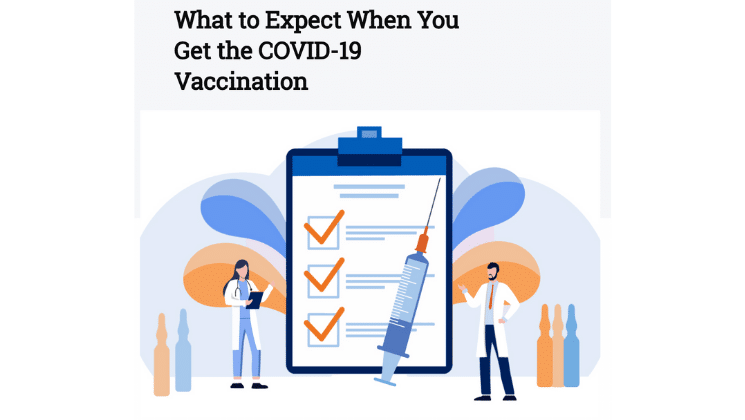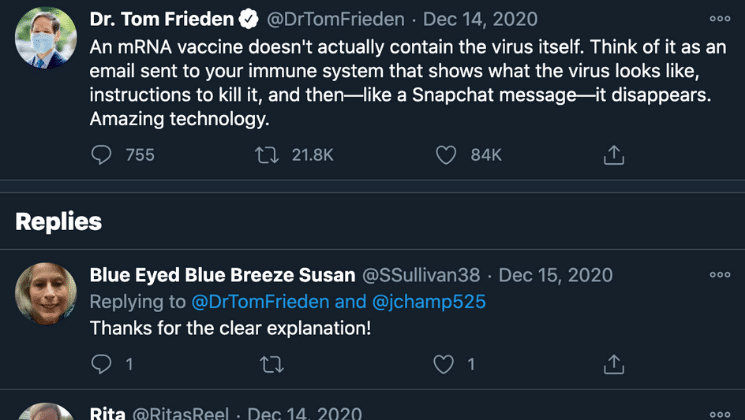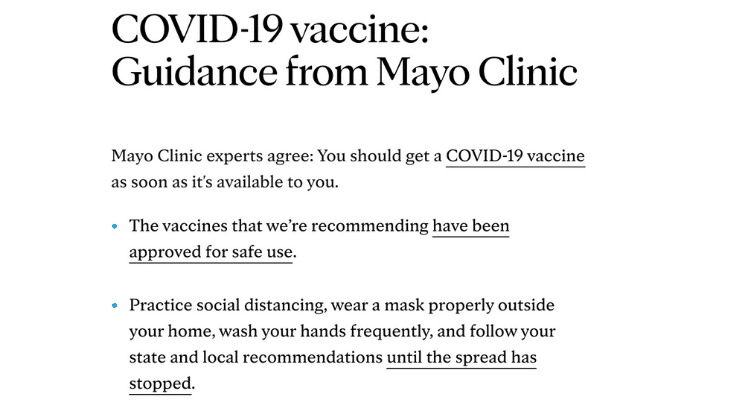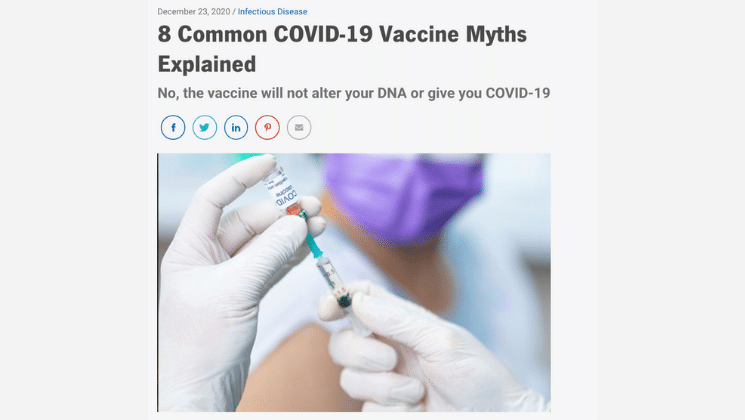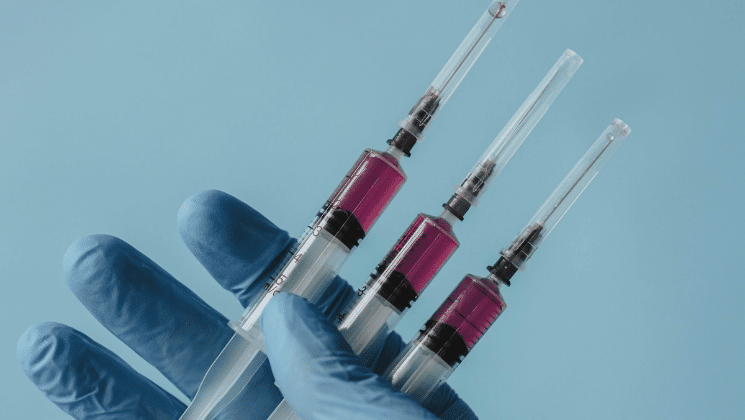
According to the Kaiser Family Foundation, 25% of the public are hesitant to receive the COVID-19 vaccines, even though an abundance of research suggests they are safe and effective. How can we contribute to ending the pandemic by inspiring trust in the vaccine?
Stellar COVID-19 Content Examples for Healthcare Communicators
You’re probably living and breathing vaccine content these days. Download our checklist for creating content about the COVID-19 vaccine. (We recently ungated this content. You’ve got enough to do right now, so we made it as easy as possible for you to get this checklist!)
Here are some tips, tricks and examples:
1. Tailor the message to your audience
Before creating content, channel your audience’s concerns and needs to give them the information they’re looking for. If you need help understanding their worries, try these tactics:
- Post callouts on social media, asking people to submit their questions.
- Ask frontline healthcare workers what questions they receive and the misinformation they encounter.
- Check search data to find out what your audience wants to know.
See it in action: Divide content into different sections for different audiences, like Johns Hopkins Medicine’s* COVID-19 vaccine page. Their page has 3 different sections: one for employees, one for patients and a patient page in Spanish. People can click on a particular section to find the details they need.
2. Engage trusted voices
There is widespread skepticism of the government, news media and public health. To combat this problem, we need trusted voices promoting the vaccine. And it helps to see healthcare workers receiving the vaccine themselves.
See it in action: Check out the byline on Connecticut Children’s COVID-19 FAQ page. It’s written by the physician-in-chief of the medical center, Dr. Juan C. Salazar. Not only does he explain the information clearly and address the specific concerns of his audience (parents), but he talks about receiving the vaccine himself. He says, “I was proud to be among the first to receive the COVID-19 vaccine.”
And Northwell Health ICU nurse shared her experience getting the vaccine in an essay. She initially had hesitations about the vaccine but explains why she received it — and why she’s encouraging her loved ones to do the same.
3. Dive into the details
People have so many questions about the vaccine and how their bodies will react to it. The more details you can share about what to expect, the more at ease people will be.
See it in action: Banner Health provides a detailed page about What to Expect When You Get the COVID-19 Vaccine. They include information about pre-screening questions, whether you should take a pain relief medication before your appointment and how long they’ll monitor you for an allergic reaction after receiving the shot.
4. Use visuals to get your point across
Get your design team involved in creating vaccine content. If you can share information with images and minimal text, go for it! Research shows that people remember pictures more than words. When it makes sense, answer your audience’s questions with images and infographics to help them better retain the information.
See it in action: Mass.gov answers the question, “When can I get a COVID-19 vaccine in Massachusetts?” with a chart. The visual breaks down when different populations can expect to get vaccinated.
5. Use plain language
Medical jargon and complicated information can make readers feel anxious. Keep your words simple and straightforward. Use similes or metaphors to help people understand complex technology or processes.
See it in action: Dr. Tom Frieden, former CDC director, compared the mRNA technology used in the Pfizer and Moderna vaccines to a disappearing Snapchat message in a tweet.
And Mount Sinai* uses visuals and short, simple sentences to explain how mRNA works in this Instagram post.
6. Make your position clear
The COVID-19 vaccine makes it essential to be clear that everyone eligible to receive it should do so. Use your voice of authority to encourage as many people as possible to get vaccinated to help end the pandemic.
See it in action: Mayo Clinic doesn’t mince words. They write, “Mayo Clinic experts agree: You should get a COVID-19 vaccine as soon as it’s available to you,” at the top of their COVID-19 vaccine FAQ page.
7. Encourage word-of-mouth marketing
People who are worried about receiving the vaccine may feel reassured by seeing friends and family receive it. How can you help with that? By providing ways for ordinary people to share that they’ve received the shot.
Think about ways you can help people share their vaccine experiences, such as:
- A social media profile image
- Merchandise (stickers, buttons or T-shirts)
- A dedicated hashtag
See it in action: Bayshore Medical Center took photos of people holding a sign that reads, “I’m a big shot,” with a space to fill in why they got the vaccine. They posted the images on their Instagram. In these particular images, Bayshore featured local firefighters (trusted individuals in the community) who share their reasons for getting vaccinated.
The CDC provides a vaccination toolkit, including this PDF of stickers you can hand out to those who received the vaccine [Covid-19 vaccination stickers (PDF)].
View this post on Instagram
8. Celebrate the vaccine!
Safe and effective COVID-19 vaccines were created in less than a year and will help end the pandemic. That’s something to celebrate. A way to combat vaccine hesitancy is to show what a big deal the vaccine is. People who are worried about receiving the vaccine may be encouraged by others touting it.
See it in action: The Boston Medical Center’s healthcare workers had a dance party to celebrate the vaccine’s arrival at their institution and shared it in a fun TikTok video.
Why I love my job @The_BMC ! Teams of people working to safely and equitably distribute vaccines to their front line colleagues getting cheered on by their friends celebrating the arrival of the vaccines! A great day, a great place. ❤️ pic.twitter.com/XfrIthFIY5
— Kate Walsh (@KateWalshCEO) December 14, 2020
9. Refute false information
Misinformation about the COVID-19 vaccine continues to grow. Fight misinformation with empathy and facts and address false claims head-on.
See it in action: Cleveland Clinic* debunks the most common COVID-19 vaccine myths one by one on their Health Essentials blog.
And viral TikTok star and scientist Dr. Noc busts false COVID-19 vaccine information in his TikTok videos.
10. Join forces with other healthcare organizations
All healthcare organizations should have the same goal around the COVID-19 vaccine: To encourage people to get vaccinated — and vaccinate them. The vaccine campaign is not a time to tout your institution’s differentiators or get more patients than a competitor. Look for opportunities to amplify the benefits of the COVID-19 vaccine by partnering with other organizations.
See it in action: An alliance of healthcare associations, including the American Nurses Association* and the American College of Preventive Medicine, teamed up with Pfizer to encourage people to get the vaccine by creating touching PSAs. The commercials remind viewers of what we can do when we reach herd immunity through vaccination.
Have you created or come across inspiring COVID-19 content? Tell us about it! Send us an email, or tag us on Facebook or Twitter.
*Indicates an Aha Media client.


